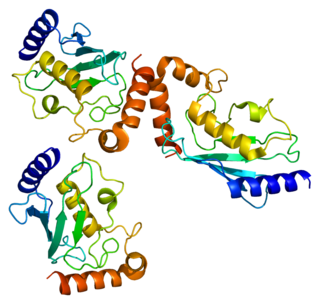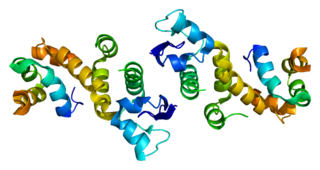Ubiquitin-conjugating enzyme E2 D3 is a protein that in humans is encoded by the UBE2D3 gene. [5] [6]
Ubiquitin-conjugating enzyme E2 D3 is a protein that in humans is encoded by the UBE2D3 gene. [5] [6]
The modification of proteins with ubiquitin is an important cellular mechanism for targeting abnormal or short-lived proteins for degradation. Ubiquitination involves at least three classes of enzymes: ubiquitin-activating enzymes, or E1s, ubiquitin-conjugating enzymes, or E2s, and ubiquitin-protein ligases, or E3s. This gene encodes a member of the E2 ubiquitin-conjugating enzyme family. This enzyme functions in the ubiquitination of the tumor-suppressor protein p53, which is induced by an E3 ubiquitin-protein ligase. Multiple spliced transcript variants have been found for this gene, but the full-length nature of some variants has not been determined. [6]

Ubiquitin is a small regulatory protein found in most tissues of eukaryotic organisms, i.e., it is found ubiquitously. It was discovered in 1975 by Gideon Goldstein and further characterized throughout the 1970s and 1980s. Four genes in the human genome code for ubiquitin: UBB, UBC, UBA52 and RPS27A.

Ubiquitin-like modifier activating enzyme 1 (UBA1) is an enzyme which in humans is encoded by the UBA1 gene. UBA1 participates in ubiquitination and the NEDD8 pathway for protein folding and degradation, among many other biological processes. This protein has been linked to X-linked spinal muscular atrophy type 2, neurodegenerative diseases, and cancers.

Ubiquitin-protein ligase E3A (UBE3A) also known as E6AP ubiquitin-protein ligase (E6AP) is an enzyme that in humans is encoded by the UBE3A gene. This enzyme is involved in targeting proteins for degradation within cells.

NEDD8 is a protein that in humans is encoded by the NEDD8 gene. This ubiquitin-like protein (ULP), becomes covalently conjugated to a limited number of cellular proteins in a manner analogous to ubiquitination. Human NEDD8 shares 60% amino acid sequence identity to ubiquitin. The primary known substrates of NEDD8 modification are the Cullin subunits of Cullin-based E3 ubiquitin ligases, which are active only when neddylated. Their NEDDylation is critical for the recruitment of E2 to the ligase complex, thus facilitating ubiquitin conjugation. NEDD8 modification has therefore been implicated in cell cycle progression and cytoskeletal regulation.

Neural precursor cell expressed developmentally downregulated gene 4-like (NEDD4L) or NEDD4-2 is an enzyme of the NEDD4 family. In human the protein is encoded by the NEDD4L gene. In mouse the protein is commonly known as NEDD4-2 and the gene Nedd4-2.

RING-box protein 1 is a protein that in humans is encoded by the RBX1 gene.

Cullin-4A is a protein that in humans is encoded by the CUL4A gene. CUL4A belongs to the cullin family of ubiquitin ligase proteins and is highly homologous to the CUL4B protein. CUL4A regulates numerous key processes such as DNA repair, chromatin remodeling, spermatogenesis, haematopoiesis and the mitotic cell cycle. As a result, CUL4A has been implicated in several cancers and the pathogenesis of certain viruses including HIV. A component of a CUL4A complex, Cereblon, was discovered to be a major target of the teratogenic agent thalidomide.

F-box/WD repeat-containing protein 1A (FBXW1A) also known as βTrCP1 or Fbxw1 or hsSlimb or pIkappaBalpha-E3 receptor subunit is a protein that in humans is encoded by the BTRC gene.

Ubiquitin-conjugating enzyme E2 L3 (UBE2L3), also called UBCH7, is a protein that in humans is encoded by the UBE2L3 gene. As an E2 enzyme, UBE2L3 participates in ubiquitination to target proteins for degradation. The role of UBE2L3 in the ubiquitination of the NF-κB precursor implicated it in various major autoimmune diseases, including rheumatoid arthritis (RA), celiac disease, Crohn's disease(CD), and systemic lupus erythematosus.

CDC34 is a gene encoding a protein product that has ubiquitin conjugating activity. CDC34 was originally discovered by work in baker's yeast as a gene that has a role in the cell division cycle. Cdc34 in yeast targets numerous substrates for ubiquitin mediated degradation. Ubiquitin-conjugating enzyme E2 R1 is a protein that in humans is encoded by the CDC34 gene.

Ubiquitin-conjugating enzyme E2 N is a protein that in humans is encoded by the UBE2N gene.

Ubiquitin-conjugating enzyme E2 D1 is a protein that in humans is encoded by the UBE2D1 gene.

Ubiquitin-conjugating enzyme E2 D2 is a protein that in humans is encoded by the UBE2D2 gene.

Cullin 3 is a protein that in humans is encoded by the CUL3 gene.

NEDD8-activating enzyme E1 catalytic subunit is a protein that in humans is encoded by the UBA3 gene.

Ubiquitin/ISG15-conjugating enzyme E2 L6 is a protein that in humans is encoded by the UBE2L6 gene.

Ubiquitin-conjugating enzyme E2 C is a protein that in humans is encoded by the UBE2C gene.

Ubiquitin-conjugating enzyme E2 E1 is a protein that in humans is encoded by the UBE2E1 gene.

NEDD8-conjugating enzyme Ubc12 is a protein that in humans is encoded by the UBE2M gene.

S-phase kinase-associated protein 1 is an enzyme that in humans is encoded by the SKP1 gene.
| This protein-related article is a stub. You can help Wikipedia by expanding it. |